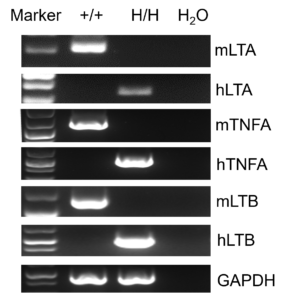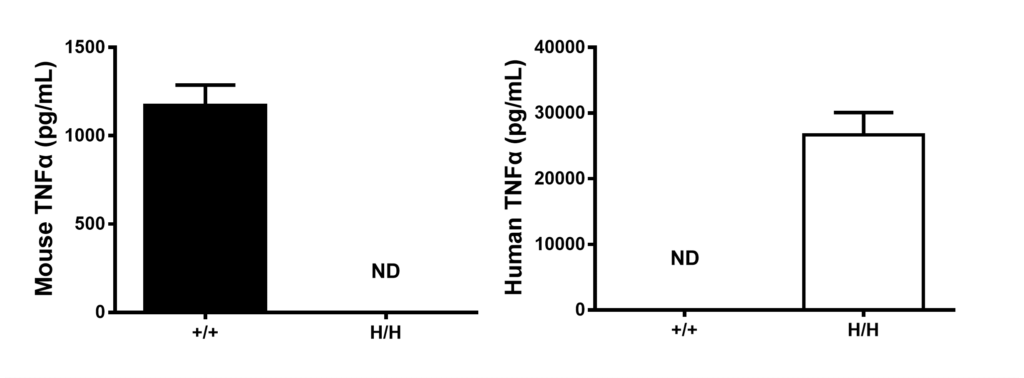Basic Information
-
Gene targeting strategy

-
Gene targeting strategy for B-hLTA/hTNFA/hLTB mice. Exons 2-4 of mouse Lta gene that encodes the full-length protein and 3’UTR were replaced by human LTA exons 2-4 in B-hLTA/hTNFA/hLTB mice. The exons 1-4 of mouse Tnf gene including 5’UTR, 3’UTR and coding region were replaced by human TNF exons 1-4 in B-hLTA/hTNFA/hLTB mice. The exons 1-3 of mouse Ltb gene that encode the full-length protein and 3’UTR were replaced by human LTB exons 1-4 in B-hLTA/hTNFA/hLTB mice.
-
mRNA expression analysis

-

Strain specific analysis of LTA, TNFA and LTB gene expression in wild type (WT) mice and B-hLTA/hTNFA/hLTB mice by RT-PCR. Mouse Lta, Tnfa and Ltb mRNA was detectable only in splenocytes of WT mice (+/+). Human LTA, TNFA and LTB mRNA was detectable only in homozygous B-hLTA/hTNFA/hLTB mice (H/H) but not in WT mice (+/+).
-
Protein expression analysis

-

Strain specific LTA expression analysis in wild type (WT) mice and B-hLTA/hTNFA/hLTB mice by ELISA. Serum was collected from WT mice (+/+) and homozygous B-hLTA/hTNFA/hLTB mice (H/H) stimulated with LPS in vivo, and analyzed by ELISA with species-specific LTA ELISA kit. LTA was detectable in WT mice (+/+) and homozygous B-hLTA/hTNFA/hLTB mice (H/H) due to the cross-reactivity of antibodies.

Strain specific TNFA expression analysis in wild type (WT) mice and B-hLTA/hTNFA/hLTB mice by ELISA. Serum was collected from WT mice (+/+) and homozygous B-hLTA/hTNFA/hLTB mice (H/H) stimulated with LPS in vivo, and analyzed by ELISA with species-specific TNFA ELISA kit. Mouse TNFA was detectable in WT mice. Human TNFA was exclusively detectable in homozygous B-hLTA/hTNFA/hLTB mice (H/H) but not WT mice (+/+) . ND: not detectable.

Strain specific LTB expression analysis in wild type (WT) mice and B-hLTA/hTNFA/hLTB mice by western blot. Spleen and thymus were collected from WT mice (+/+) and homozygous B-hLTA/hTNFA/hLTB mice (H/H), and analyzed by western blot with anti-LTB antibody. LTB was detectable in WT mice (+/+) and homozygous B-hLTA/hTNFA/hLTB mice (H/H) due to the cross-reactivity of antibodies.
-
Summary

-
mRNA expression analysis:
Mouse Lta, Tnfa and Ltb mRNA was detectable in thymocyte of WT mice (+/+). Human LTA, TNFA and LTB mRNA was exclusively detectable in homozygous B-hLTA/hTNFA/hLTB mice (H/H) but not in WT mice (+/+).
Protein expression analysis:
LTA and LTB were detectable in WT mice (+/+) and homozygous B-hLTA/hTNFA/hLTB mice (H/H) due to the cross-reactivity of antibodies. Human TNFA was exclusively detectable in homozygous B-hLTA/hTNFA/hLTB mice (H/H) but not WT mice (+/+) .
-
Related products

-


